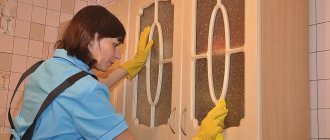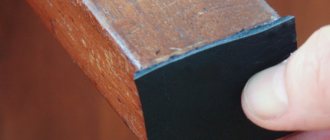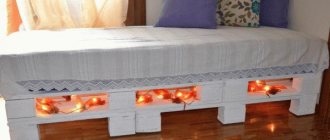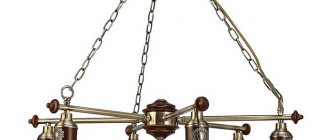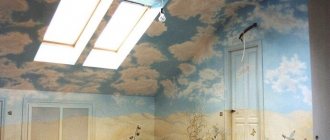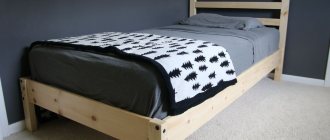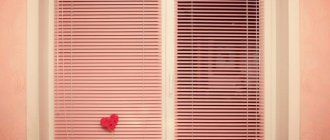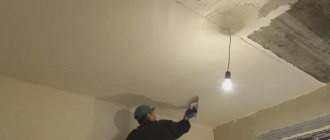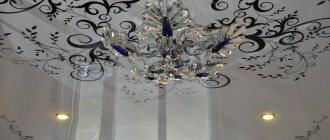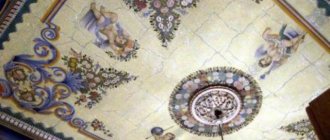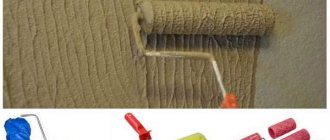Peculiarities
The need to update the appearance of a painted ceiling arises quite often. This is the least expensive process in terms of effort and time. Many property owners choose it precisely because of these advantages, but they also face the question of how to reapply the paint so that the surface is painted as evenly as possible and there are no streaks left on it.
This type of finishing work is easy to do with your own hands, the main thing is to know some of the features of such work.
- If the old coating layer is in good condition, has no chips, cracks, is not flaking, is not flaking, has simply faded and lost its attractiveness, then painting can be done over the old coating. This process will not require a lot of money and time, since no preparatory work is needed. There is also no need to putty the surface before painting it.
- If the ceiling has already been coated with paint, and the surface has small fragments of peeling material, do not despair; the layer of water-dispersion paint does not require complete removal. In such a situation, it is enough to clean the exfoliated areas and apply the coloring composition over the old coating.
- If there are severe finishing defects, additional work cannot be avoided. Painting agents cannot repair cracks, irregularities and wrinkles; such defects require the consumption of additional building materials.
The old paint layer should be completely removed. This can be done with a spatula, thoroughly cleaning the entire surface. Using a brush and a special product, you need to start priming the ceiling. After the primer layer has dried, the surface must be well puttied, correcting all irregularities and defects. A special base for water-based paint should be applied to the dried surface; this layer precedes painting.
How to paint a ceiling with water-based paint - operating procedures, tips and rules
For many decades, painting the ceiling with water-based paint has remained one of the most popular finishing methods. This coating is environmentally friendly and universal, as, thanks to its matte finish and a wide selection of shades, it will suit any interior. The low cost of materials is one of the advantages of painting with water-based emulsion. However, for a high-quality result, this type of finishing requires careful preparation of the ceiling and some painting skills.
High-quality paint is the main component of success
For the best painting result, it is worth taking into account the characteristics of different types of water-based paint. The best option for ceilings is acrylic water-based paint; the addition of latex increases the elasticity and strength of the coating, and also allows you to repair small cracks. More economical options are paints based on acrylic copolymers (vinyl acrylic, styrene acrylic).
The largest number of positive reviews are collected by products from German manufacturers; Polish and Russian factories also produce high-quality, but less expensive paints. The main thing is that it must be factory-made and not a fake. In any case, high-quality water-based paint cannot cost less than 180 rubles per liter.
On the can or bucket of paint there should be instructions for applying it and the cost of painting one square meter. Knowing the consumption, you can independently calculate how many liters of paint you need to purchase to paint the ceiling.
Immediately before work, you need to prepare the paint by adding cold water to the consistency of kefir (5-10% of the paint volume) and stirring thoroughly (you can use a drill with a special attachment). If you want to give the ceiling a tint, you can add color to the paint container. You should start with a few drops, adding very gradually so as not to get too bright a shade. The resulting colored paint requires particularly careful mixing.
Tools and auxiliary materials
The most necessary tool for painting the ceiling is a roller, since using a brush it is impossible to create a perfectly even coating on a large surface. Its size directly depends on the area to be painted; the larger it is, the thicker and longer the roller should be.
Foam rollers are more suitable for applying glue. To paint the ceiling, it is better to choose a roller with a small, velor-like, pile. If you want to add a light texture to the coating, you can use a long-nap roller. Plus, it takes more paint, and the job will move faster. The retractable handle for the roller eliminates the need for ladders and tables and reduces the risk of injury.
A wide (up to 8 cm) flat brush is still needed for painting corners. It is better if it has fluffy ends, in which case there will be no streaks left on the surface to be painted.
To match the length of the roller, you need to select a plastic paint tray with a ribbed spin pad. The roller is dipped into the paint and then rolled over the surface several times to remove excess paint and apply it evenly to the roller. Using this inexpensive device will greatly simplify your work and improve the quality of your painting.
Preparatory work
It is impossible to achieve a good result when painting with water-based paint if preliminary work is not carried out. By the time of painting, the ceiling must be cleared of the previous coating, glued with reinforcing mesh at the joints of the panels, leveled, puttied and sanded until smooth. You can also paint over old water-based paint, provided that it does not come off anywhere and there are no cracks in it. Otherwise, you will have to carry out all the above work. Then the primer is applied with a roller. and after it has completely dried, the ceiling is ready for painting.
If you are painting a ceiling made of plasterboard sheets, then you should glue all the joints with mesh, putty and sand the screw heads. If the concrete floor panels are smooth and without noticeable potholes or defects, you can apply water-based latex paint in several layers directly onto the primed concrete. The latex in the paint will fill out small pores and roughness, and this coating will look quite satisfactory.
Before painting, you must remember to remove all the furniture from the room or cover it with oilcloth. It is worth taking care of the safety of the floors if they are not planned to be replaced.
Painting
They begin work by painting the corners and perimeter of the ceiling, which is more convenient to do with a brush. The strokes should run parallel to the window. The ceiling is painted from the wall with the window; if they are located on several walls, then the one from which more light comes is selected. At the same stage it is worth painting the ceiling cornices, if any.
A small amount of paint is poured into the tray, a roller is dipped into it and rolled several times, squeezing out excess paint. The paint is applied to the ceiling using small zigzag movements, evenly and gradually. While the paint has not thickened, you can go over it with an empty roller to remove excess paint. From time to time it is worth stepping aside and looking at the ceiling from a different angle to notice unpainted areas.
After completing one coat, the ceiling should be completely dry. This takes at least several hours. Do not try to speed up the drying of the paint, as this can lead to cracks and peeling.
The next layer of paint must be applied perpendicular to the previous one. For a high-quality result, at least two layers of water-based paint are applied. The last layer is applied perpendicular to the wall on which the window is located. After each painting, the rollers and tray must be thoroughly washed.
Painting tricks
- Before painting the ceiling, it is worth practicing on a small area of the wall or drywall to get used to the roller and paint.
- The paint should cover the roller as evenly as possible. This will prevent unpainted areas and stains from appearing on the ceiling.
- Do not roll out already set paint with a roller, this will lead to streaks and deformation of the coating.
- It is better to take paint with a reserve, since even different batches of the same brand may differ slightly in color.
Sources:
Process Features
Painting the ceiling is not as difficult as it seems at first glance. As a rule, before this process, workers remove the old layer of finish. The fact is that a thick layer of old paint can show through and spoil the appearance of the surface. If cracks appear on the ceiling, then the matter is completely hopeless - no matter how you paint them, they will still be visible. If repairs have not been carried out for a long time, then under a layer of old paint you may even find mold, which will negate all your attempts to update the surface.
If there are no such serious problems, then you can safely apply a new layer of water-based emulsion or acrylic to the old paint. Take a close look at your ceiling. If you are satisfied with its appearance, and pieces of paint do not fall off, you can leave everything as it is.
Professionals also advise paying attention to the following: if you have previously painted the ceiling with water-based paint, then you are in luck. It's better than whitewash. Even if this type of paint begins to flake off and fall off in pieces, it may not be completely removed. You can easily limit yourself to superficial cleaning by removing loose pieces and cleaning the area around them. After this short work, you can safely apply a new coat of paint.
Paint selection
If you decide to paint the ceiling over the old layer of material, then you will have to face the question of choosing the appropriate option. For such work, different paints are used. Each type has its own advantages and a number of disadvantages.
Acrylic
Perhaps this type of paint is the most popular. It is good because it is highly resistant to all kinds of dirt and dries quickly. So you can safely use this material, for example, in the kitchen, where working with food is not always neat.
This paint also withstands high humidity well. If there is any contamination on the painted surface, it can be easily removed with a damp cloth or napkin without fear of the paint cracking.
Acrylic paint can be easily applied to a variety of surfaces. It fits well on metal, wood, plastic, and even on already plastered substrates.
Painting with acrylic is also good because it perfectly hides minor surface imperfections. Textured paint can mask small cracks or places where pieces of the coating have already fallen off.
How to paint a ceiling with water-based paint over old paint
Only owners of tension systems do not have to wonder about updating the paint on the ceiling. In all other cases, sooner or later you need to refresh the ceiling covering. As a rule, this requires a lot of dirty work that requires a lot of time and effort. First, all layers of the old coating are removed, the surface is primed, puttied and sanded. After this, re-priming is carried out and, finally, a new layer of paint mixture is applied.
Not everyone wants to spend so much time, so some apply water-based emulsion directly on top of the old paint layer. Can such a coating last long or is there no point in such treatment?
Forgotten traditions: painting the ceiling with water-based paint
A wide range of building materials and many examples of exclusive design make it possible to create the ceiling of your dreams - beautiful, elegant, even luxurious, with bright lighting and fashionable design. But sometimes a masterpiece of construction craftsmanship is simply not needed: for example, in a utility room, a clean, white, smooth ceiling surface, which can be achieved with ordinary painting, looks great. Let's look at how to paint a ceiling with water-based paint to make it look beautiful and flawless.
Advantages of a painted ceiling
We will not discuss the disadvantages of simple painting, and it is clear that this is the most basic way to refresh the appearance of an old ceiling. Anyone who decides that applying a water-based emulsion is a fairly easy way would be mistaken; this is far from the case. A truly smooth and uniform surface can only be achieved through a long and labor-intensive process, including plastering, priming and painting.
So, what are the advantages of painting? If the ceiling is initially smooth and problem-free, there are a lot of advantages:
- efficiency;
- rapidity;
- ease;
- availability.
A well-plastered and painted ceiling looks no worse than modern tension systems.
Just one evening - and you are guaranteed the freshness of a snow-white surface. If there are irregularities, you will have to first plaster, but in any case, the cost of repairs will be small, it will just take more time and effort. But there will be no questions about how to repaint a ceiling that has already been painted with water-based paint. One new coat and the repair is complete.
Stages of painting the ceiling with water-based paint
There are two options for finishing the ceiling with water-based emulsion: simple painting and multi-stage preliminary preparation for further painting. We will consider a complete, long-term option so that there are no questions about how to properly paint the ceiling with water-based paint. For those who need regular painting, look only at the beginning and end of the instructions, skipping the stages of plastering and reusable primer.
We choose the shade of the ceiling depending on the surrounding interior and wall design
Preparation of tools and materials
Preliminary preparation will save time and give you the opportunity to work calmly, without being distracted by visiting stores and looking for some small thing - a roller or spatula. Of course, there will be periods of planned downtime, “to dry things out,” but it’s still better to stock up on everything you need in advance.
When choosing brushes, check the strength of the bristles
So, for all stages of work you will need the following tools:
- steel spatulas, narrow and wide;
- containers for water and paint;
- wide and narrow paint brushes, preferably several;
- sponge or wool roller;
- grout mesh, sandpaper;
- painting tray with drain.
The best tool for painting is a roller, which can be extended with a special rod.
As you can see, this is a fairly inexpensive set that will cost no more than 1000 rubles. You will spend a little more on materials, especially if you have an uneven ceiling surface covered with pockets of mold.
You will need:
- primer for plaster;
- antiseptic;
- deep penetration primer;
- dry plaster mixture;
- finishing putty;
- water-based paint.
Water-based paint can be replaced with a more modern acrylic analogue.
The consumption of all products is indicated directly on the cans, so calculating the volume is not difficult. You should buy enough paint to cover 2 layers. Tap water is suitable for diluting dry mixtures. Let's see how to paint a ceiling with water-based paint if it is completely unprepared.
Among water-based and water-dispersion paints there are paints and varnishes for rooms with high humidity
Cleaning the work surface
Wet the surface with peeling old paint or a thin layer of gypsum plaster with water using a wide brush. We clean off the slightly dissolved materials with a narrow spatula and rub them with coarse sandpaper. If the pieces of plaster are large and hold quite firmly, we use a hammer drill. We also remove mold and mildew stains with a sharp spatula. Then wipe the entire surface with a wet cloth. As a result, the ceiling should be completely cleared of old material and ready for processing.
It is necessary to remember how to prepare the ceiling for painting with water-based paint if there is a predisposition to the new appearance of mold. There are special antiseptic agents on sale that penetrate deep into concrete, brick or wood and prevent the new formation and spread of fungus. It is better to apply them in several layers to already infected areas and a thin layer over the entire surface - for prevention.
Preliminary or deep primer
The necessary preparation of the ceiling for painting with water-based paint includes several additional steps, each of which is important in its own way. Impregnation of the slabs with a special liquid - a primer - is necessary to achieve two goals:
- to improve the adhesion of plaster to concrete;
- to save other material (plaster, putty or paint).
Carefully coat the cleaned, leveled, antiseptic-treated ceiling surface with a deep penetration primer. In addition to its main functions, it will make the ceiling surface smooth, uniform, close small cracks and at the same time prevent the appearance of mold. The plaster will lie firmly on the primed base and will last a long time.
For ceiling decoration they offer hundreds of shades of all colors of the rainbow
Plaster for leveling
Get ready for the most difficult and time-consuming stage. You will have to use a wide spatula to apply plaster to the ceiling and level it over the entire area. If there are deep cracks between the slabs or differences at the joints, a lot of plaster mixture will be needed.
The work plan is as follows:
- We use a laser level to determine the work horizon;
- prepare the plaster solution - dilute the dry mixture with water and mix thoroughly with a drill with a special attachment or a regular stick;
- first we seal the most uneven, critical places; wait a little until it dries and continue plastering over the entire area of the room;
- As a final layer, we apply finishing putty, which, after drying, is carefully sanded with a mesh or sandpaper until perfectly smooth.
This completes the preparation of the ceiling for painting with water-based paint. The only thing that can still be done to improve the quality of painting is to perform additional priming. This will save some paint and improve the texture of the applied layers.
Painting with water-based emulsion
The final stage is the easiest to perform. It is done quickly, because the technology of painting the ceiling with water-based paint is simple. Pour the water-based emulsion into the paint tray, dip the roller into it, carefully roll it out onto a special tray and carefully apply the first layer of paint to the ceiling. We wait for it to dry and look at the result. If you look at the painted surface from different points, at different angles, you will notice the “gaps” that have been made. There is nothing to worry about; during the process of applying the second layer, they will disappear and the ceiling will become smooth and uniform. It is better to handle the corners with a brush rather than a roller.
You may ask: how to renew a ceiling painted with water-based paint? Quite simple: take a similar paint, which, if necessary, can be slightly diluted with water (but not more than 10% of the total composition), and apply it over the existing one.
Use a brush to paint narrow and hard-to-reach places
A few words about color. Now it is possible to use any pastel color instead of a snow-white shade. The paint is prepared directly in the supermarket, the shade is chosen to your taste from dozens of proposed options. The desired color is mixed with a white base and the color needed to finish your ceiling is obtained.
Master class on painting the ceiling
toppotolok.su
Is it worth applying new paint over old?
There is no clear opinion on this matter. If you ask a specialist, he will say that there must be good adhesion between the two materials, which can only be achieved if the surface is first cleaned of the old coating.
But, in practice, many people carry out such cosmetic repairs and forget about problems with the ceiling for a long time. However, in this case it is necessary to take into account several important aspects:
- It is recommended to apply a composition to the ceiling that will be similar to the one that was used previously.
- If there are already many layers of paint on the ceiling and serious defects are visible, then in this case it is still worth dismantling the old coating. If part of it is already falling off, then a fresh layer will only be able to contain it for a very short period.
- If lime whitewash was previously applied to the ceiling, then in this case there is only one option - remove the old coating and process it according to the standard scheme.
It is worth paying attention to the fact that water-based emulsion and water-based emulsion are different. Gone are the days when there was only one type of mixture available. Today there are paints on sale that are not resistant to water and compositions that, on the contrary, cannot be washed off so easily. If the old coat is water-based and you plan to use the same type of paint, then it is better to remove the old coating. The fact is that while you are applying new paint, the old one will begin to be damaged. This will cause peeling.
In what cases is it better not to paint the ceiling and walls over whitewash?
Do not paint with water-based paint over uneven whitewash.
The demand from specialists to dismantle the old coating in most cases is not caused by a desire to complicate life or add work, but by the need to protect people from future problems.
Pay attention to: Criteria for choosing paint for the facade, preparing the outer wall for painting and caring for the surface
A whitewashed ceiling and walls, after treating them with water-based or acrylic paint, may simply lose their attractiveness, since under the lime coating the condition of the base, which has various defects, such as cracks and chips, depressions, is not visible.
When painting whitewashed surfaces, deformation of the new coating is possible due to unevenness of the old layer. The whitewash gets wet under the influence of the absorbed paint and then becomes sticky. In this case, lime sticks to the roller or brush and is then spread over the surface to be treated.
In addition, you will have to wash off the old whitewash in the following cases:
- There is a thick layer of plaster on the ceiling and walls. Due to its hygroscopicity, it will absorb paint, then swell, crack and collapse. In this case, the paint will bubble and become covered with cracks.
- If there are traces of leaked water on the surfaces being treated, then the paint, despite the selection of colors and textures, will stand out sharply in these places. Any attempts to correct the situation will not be successful.
- Old walls and ceilings have defects such as microscopic cracks and pits. Painting such a surface will sharply highlight these imperfections. Therefore, first you will have to work with a spatula and putty.
- Traces of mold and fungal infection appear. If you paint over them, these simple organisms quickly spread over all surfaces. Therefore, when this danger is identified, it is necessary not only to wash off the whitewash, but also to treat the room with antiseptics.
- The old coating begins to crumble spontaneously. Adding paint will speed up this process.
If at least one of these factors is identified before starting the repair, you will have to remove the old lime and then start painting.
Types of water emulsion
All paints belonging to this category are water emulsions, which consist of pigment particles and binding components. Today you can find many varieties of such compositions on sale:
- Acrylic. This is the most popular option, which is used for residential premises. It is easy to guess that acrylic resins are present in such mixtures. This water emulsion also contains latex additives. All this makes acrylic paint durable and resistant to moisture. Due to its high elasticity, it hides unevenness of the old coating well and penetrates into cracks no more than 1 mm wide.
- Silicone. These are waterproof and resistant water-dispersed compositions, which are essentially an intermediate form of chemically pure organics and substances of inorganic origin. As a rule, they are used for bathrooms and other rooms with high humidity. Silicone resins make it possible to create a reliable coating, but it should be noted that such water-based emulsions are not suitable for ceilings if there are large defects on it. This paint is used if there are cracks on the surface of the spruce tree no more than 2 mm wide.
- Silicate. These compounds resemble silicone ones. Only in this case the basis is liquid glass. Additionally, the composition may contain silicon-organic resin. However, they are very expensive, and their characteristics are more than enough for a residential area, so they are most often used in the industrial sector.
How to renew a ceiling painted with water-based paint
A high-quality painted ceiling is a decoration for any room. But over time, it may fade, while the surface itself will remain smooth and the putty will remain undamaged. Sometimes it happens that the ceiling repair is not done well and there are grooves and irregularities on it. These flaws must be combated. Let's look at how to update a ceiling painted with water-based paint so that it gets the look you want.
Today, water-based painting can quickly restore the appearance of your ceiling. Despite new technologies for finishing ceilings in the form of suspended or tensioned structures, many are in no hurry to do this for many reasons. Firstly, simply painting the ceiling will cost much less, and you can do this work yourself. Secondly, hanging structures are not suitable for many people, since the height of the walls in the room is not large anyway. And sometimes owners of the old school simply don’t want any innovations. In this article we will learn how to renew a ceiling painted with water-based paint.
Today on sale you can find many materials intended for painting the ceiling. Among the many manufacturers and the variety of shades, you can get confused and buy paint that does not suit you at all. Water-based paints may differ from each other in composition, consistency, and also in their characteristics.
Water based paints division
•Acrylic coatings are considered the best and are popular. They contain resins that bind the paint and give it elasticity. Some of these compounds are resistant to moisture because they contain latex. Acrylic paints spread well over the surface and are durable. Their color palette is based mainly on pastel colors. But to give a brighter color, these paints are tinted to the shade you need. You can do the tinting in a store or at home.
•Mineral paints are made on the basis of limestone and cement and do not have such a wide range of applications. And all because such coatings are not stable and cannot last long.
•Silicone coatings are based on silicone resins and acrylic copolymers. They protect the surface from the formation of fungi and mold and are vapor-tight.
•Silicate coatings are the most moisture-resistant among similar ones. In addition to the silicate base, they contain pigment colors and liquid glass. But it is not recommended to use such coatings in sleeping areas. An excellent option for silicate paint would be the bathroom, as well as other utility rooms and exterior treatments.
If you have chosen paint and know how to update a ceiling painted with water-based paint, then it is worth noting the fact that the ceiling coating can be matte or glossy. By purchasing matte paint, you can hide minor unevenness on the surface under it. While glossy paint, on the contrary, will highlight all the imperfections, glossy paint can be washed. Therefore, it is recommended to use this coating only on a perfectly flat surface.
How to repaint the ceiling surface if it is already painted with water-based paint
We arm ourselves with a roller for painting the main ceiling canvas, and a brush for painting hard-to-reach areas. Mix the paint well, dilute it with water if necessary, and pour it into the painting tray. We take a stepladder and from it we begin to paint the ceiling with the first layer across the room. We make overlapping strokes with a roller, capturing part of the already painted surface.
You should not put a lot of paint on the roller, and before transferring it to the ceiling, you need to roll out the tool on the tray itself. The second layer of paint is applied after the first has dried, but not in breadth, but along the room. If you notice a flaw on a painted surface, you should not repaint it; you will do this when painting the next layer. Large surfaces are best painted with a spray gun.
Now you are familiar with how to update a ceiling painted with water-based paint. But it is worth knowing that after painting the first layer, some flaws become visible. They must be sanded before painting the second layer.
Painting the ceiling
If it was decided not to remove the old coating, then some work will still have to be done.
Preparatory work
At this stage, it is recommended to carefully inspect the ceiling covering and assess its condition. Experts recommend using special lighting “at an angle”, this will reveal all the flaws. If there are serious defects on the ceiling, then it is necessary to remove the exfoliated elements, apply putty to those places where there are deep potholes and treat everything with a primer.
Important! If you find mold on the ceiling, you must get rid of it and treat the area with a special impregnation that will prevent the spread of spores.
The prepared ceiling dries quite quickly. For example, if you applied primer in the morning, then after lunch you can start painting. The second layer of water-based emulsion (if necessary) is usually applied the next day.
Painting
The work of applying a fresh layer of water-based paint over the old layer looks like this:
- We prepare the necessary tools. To work, you will need a brush 3-4 cm wide, a roller, a paint tray (cuvette), a rag and a telescopic handle. You also need masking tape and polyethylene (or you can buy a special covering material with adhesive strips).
- We cover the furniture and floor with polyethylene.
- We study the instructions for the selected paint. Some formulations are sold ready-made, others require dilution with water. In addition, you may need to add pigment (color) if you plan to create a colored ceiling covering. It is also important to adhere to exact proportions, as they may differ depending on the manufacturer of the coloring composition.
- Pour the required amount of paint into the cuvette. We dip the brush into the composition, blot it so that the paint does not run off and thoroughly treat all the corners and joints. Also, using a brush, decorative elements made of plaster, if any, are processed.
- We take a roller and begin processing the ceiling. In the wide part of the cuvette, the roller is wetted, and in the narrow part it is blotted and rolled several times so that the paint is evenly distributed over it.
- Moving the roller in parallel movements, we begin to apply the composition. It is necessary that each subsequent strip overlaps the previous one by half.
- If you need to add another layer, then this should be done the next day. Experts recommend applying the finishing layer parallel to the window or other light source. To do this, you should use a new, soft and better quality roller attachment. This will give you a smoother finish.
If the previous coating is damaged or is a whitewash, then it is better to remove it.
Ceiling preparation
1 - direction of the first layer of paint, 2 - direction of the second layer of paint.
To get started with whitewash removal, you will need the following tools:
- respirator;
- putty knife;
- brush;
- roller;
- container with water;
- spray;
- Sander;
- sandpaper.
There are two ways to get rid of old whitewash: dry and wet.
For the dry version, use a grinding machine or sometimes a drill with a special attachment. There is one drawback when using them: dust will immediately rise around and it will be impossible to work without a respirator and goggles. In addition, this option is not very healthy. Therefore, it is better to use the wet method.
Methods for removing whitewash: a – removing whitewash using a solution and a roller. b – removing whitewash using a spatula.
Before you start using any of the methods, you will definitely need to cover all furniture and floors from dust. To do this, you can take regular oilcloth. You can also use oilcloth to cover doors and windows.
Before starting work using the wet method of removing lime, wet a small part of the ceiling with water. You can use a brush, an ordinary roller or a spray bottle. For this method to be effective, it is recommended to use soap and soda ash, which are dissolved with water, instead of water. To prepare such a solution, you need to grate 2 tablespoons of soap and dissolve in 10 liters of water, add 5 tablespoons of soda to this and mix well. And generously wet the whitened areas of the ceiling with the solution, as well as water.
It is necessary to moisten the whitened surface with water or solution very strongly. Lime is not moisture resistant and absorbs water very well. The more it absorbs, the easier it will be to tear it off the ceiling later.
When the whitewash is sufficiently wet, you should begin removing it with a spatula.
When the whitewash is sufficiently wet, you should begin removing it with a spatula. This way you can gradually clear the entire ceiling of whitewash. But it happens that after this there are places where the remains of lime are still visible, you need to wet them again and go over them with a spatula again.
If this does not help, then feel free to pick up a sanding machine. At the same time, we must not forget that when using this machine, indentations remain on the surface, so you need to work carefully so as not to damage the putty. And it is important to remember about a respirator, since the work of a grinding machine produces a lot of dust. When such a machine is not at hand, a regular hammer is used, which is used to tap difficult places and remove the lime with a spatula.
When the ceiling is cleared of whitewash, you need to go over it with sandpaper. But this is optional.
So, the ceiling is ready to be painted. Before proceeding to this stage, there are a few more nuances that should not be forgotten.
It is necessary to paint from one wall to another with a slight overlap.
Prepare the following materials:
- construction mixture;
- priming;
- dye;
- roller;
- brush;
- glasses;
- spray gun.
After cleaning the remaining lime using sandpaper, the ceiling must be primed. To do this, you just need to walk a roller or brush dipped in soil a couple of times along the surface of the ceiling.
If there are still noticeable unevenness on the ceiling, then putty will help to level them out. After using it, it is recommended to walk over the surface with soil again.
That's all. Now the ceiling is ready to be painted. Using a roller or sprayer, apply even layers to the ceiling and allow to dry. Enamel or water-based paint is ideal for the ceiling.
Features of dismantling the old coating
If lime whitewash was previously used on the ceiling, the easiest way to get rid of it is to thoroughly wet the ceiling surface. Lime has excellent absorption, so it is best to apply water several times. The thicker the whitewash layer, the more moisture will be required.
After this, you need to open the windows in the room. In draft conditions, the lime will begin to bubble and quickly peel off. After this, it can be easily removed with a regular spatula. You need to wear safety glasses when working, after which it is recommended to rinse the surface again with water.
If you need to dismantle a layer of old water-based paint that is badly damaged, then of course you can try to wash it off or get rid of it with a spatula. But this is a very long and tedious process. Therefore, it is best to use a special chemical composition that will quickly corrode the old paint. However, before using it, you need to carefully study the instructions. Work is carried out in a respirator, safety glasses and rubber gloves. Additionally, you need to take care of good ventilation of the room. The water-based emulsion quickly reacts with the chemicals and begins to bubble, after which it is easily and quickly removed with sandpaper and a spatula. At the final stage, it is enough to rinse the surface with water.
If there are large cracks and potholes in the ceiling, they need to be filled. After this, the irregularities are erased with fine-grained sandpaper.
Method of applying water-based compositions
How to ensure quality?
If you decide to paint the ceiling with water-based emulsion with your own hands, then you need to take into account that without preparation the result will be disastrous.
Removal technique
- Firstly, it is important to clean the base from old whitewash. It is convenient to remove a thick layer with a spatula, and wash off the residue with water from a spray bottle.
- After cleaning the ceiling, it is necessary to expand and seal all cracks. As a rule, large defects do not form in concrete slabs, so we focus on the joints of the parts and the junction with the walls. To prevent “cold bridges” from leading to paint peeling, we fill all voids with sealant or cement mortar.
Advice! As a rule, in damp rooms the base is impregnated with an antiseptic before leveling. This impregnation helps to avoid contamination of the painted layer by fungi and bacteria.
- Next, we level the overlap. You can only use putty, but it is better to mask large differences with plaster. If the difference in height is more than 20-30 mm, then it is more rational to install a suspended structure made of gypsum board: it will be cheaper and more reliable.
- The surface is finally leveled with finishing putty, which is then sanded and primed. This, on the one hand, will ensure adhesion of the paint to the base, and on the other, will allow us to get a perfectly flat ceiling.
Advice! If there are metal parts on the ceiling, then Zinga conductive paint or other zinc compounds are used to protect them from corrosion.
Painting Tips
As a result of preparation, we should get the surface that is most suitable for solving our problems. If you whiten it, the coating will be of better quality than when processing the floor itself.
However, since we have already spent time and money, it is worth using high-quality finishing:
The perimeter is painted as shown in the photo. This will protect the walls from drops
- We dilute the paint by half and apply the first layer. In order not to stain the walls, we paint the perimeter with a brush, and then use a roller or sprayer.
Advice! The floor must be covered, since drops will occur even with the most careful work.
- Apply the paint in parallel stripes, making sure there are no unpainted areas.
- Dry the first layer (time depends on the type of material) and re-paint the ceiling with a thicker mixture. In this case, we move the roller in a direction perpendicular to the one in which we worked at the first stage.
- If you have chosen a paint with good hiding power, then two layers will be enough. After this, it is enough to dry the ceiling with good ventilation.
Finishing
Painting the ceiling with water-based paint over old paint
The advantages of water-based coating - the absence of a strong odor and toxic properties, the formation of a durable layer that allows cleaning, wiping and washing, the possibility of tinting - have made it a popular material for decorating ceilings.
However, such painting, especially over a layer of old paint, has a number of features and mandatory preliminary operations.
Painting the ceiling with water-based paint over old paint
How to paint it yourself?
To paint the ceiling with your own hands, you do not need to have experience in performing such work. If you follow simple rules, the finish will delight you with its appearance for a long time.
Coloring rules
- It is necessary to provide good lighting to control the progress of painting.
- Following the manufacturer's recommendations, you need to observe temperature conditions when painting and avoid drafts.
- Painting should begin from the corner farthest from the door, that is, from the window. If painting is done in two layers, the first is applied along the window, the final one is applied across, that is, in the direction of the light.
- To avoid streaks, do not turn the roller over to the other side during the painting process.
- It is not permissible to interrupt work until the layer is completely applied. Stopping causes the coating to dry out at the joints of the painted and unpainted surface. Uneven areas are very noticeable in good lighting.
To avoid unpainted areas and uneven areas, you need to work quickly. You need to correct defects before the paint hardens. In this case, you can get an excellent painting result.
- It is necessary to constantly monitor unpainted areas and thickenings and eliminate them before the paint layer dries. It is better to inspect the ceiling from different angles before applying a new portion of paint.
- If possible, use a new roller for each coat to improve paint quality.
Ceiling preparation
Before painting the ceiling, you need to prepare the surface for painting. To ensure that the paint goes on smoothly and evenly in the future, you must adhere to the following sequence of actions.
- First you need to get rid of the old whitewash or paint on the ceiling.
- It is necessary to carry out plastering work to seal the seams between the floor slabs and eliminate cracks and irregularities.
- The next step is to apply a primer.
- The next step is to putty it before painting. You need to be especially careful when choosing materials if you are going to putty a plasterboard ceiling for painting.
- Finally, it is necessary to sand the surface with fine-grained sandpaper.
Step-by-step instructions for painting the ceiling with water-based paint
In accordance with the technology of painting the ceiling with water-based paint, it is necessary to perform the work in the following order.
- Stir the paint. To avoid the appearance of small lumps, you can filter through gauze folded in several layers.
- Place the roller in the paint tray. It is necessary to roll the tool along the ribbed side several times so that it is evenly absorbed.
- The first layer must be applied parallel to the window, the second - perpendicular. It is better to move the roller from the wall to the window to be able to evaluate how the paint lays down.
- Roll the roller with a 5-10 cm wide overlap onto the previously applied strip of paint. To ensure the necessary force, the angle between the tool handle and the surface to be painted should be no more than 45 degrees.
- Carefully paint the junction of the walls and ceiling and the areas behind the heating pipes with a brush.
- If after two layers stains and unpainted areas are visible, it is necessary to apply a third. For the previous coat of paint to dry, you need to wait about 12 hours.
Video tutorial
The following video describes the features of painting the ceiling. Following the recommendations from the video tutorial will help you avoid mistakes in your work.
Tools and materials - a complete list for all occasions
To carry out the necessary preparatory work and high-quality painting of the ceiling with any composition of the previous coating and surface condition, you will need:
- wide, durable plastic film or oilcloth to cover the floor and furniture that could not be removed;
- sponge for soaking and washing off old coating;
- steel spatula for removing the previous layer of paint (whitewash) and applying putty when leveling the surface for painting;
- serpyanka mesh for gluing the joints of ceiling tiles;
- main and finishing putty;
- penetrating primer;
- mesh graters for leveling the putty surface - larger preliminary and fine finishing;
- special solutions for eliminating yellow streaks, rust stains, and mold;
- water-based paint of suitable quality in the required quantity;
- a medium-width brush with a fluffy edge for painting corners, joints with walls, areas around ceiling lamps; before use, it is soaked in water; the swollen wood of the handle will tightly hold the bristle hairs, so they will not remain on the surface covered with the coloring composition;
- a narrow brush for eliminating minor paint defects;
- a paint roller in a fur coat with medium-length pile and a handle with a telescopic extension; the width of the roller depends on the area of painting - the larger it is, the wider the roller;
- a rectangular tray with a corrugated inclined surface on which a roller is rolled to remove excess paint.
Necessary tools and materials: 1. Film. 2. Sponge. 3. Spatula. 4. Serpyanka mesh. 5. Putty. 6. Primer. 7. Grater nets. 8. Cleaning products. 9. Paint. 10. Medium brush. 11. Narrow brush. 12. Roller. 13. Special bath.
Water-based paint for whitewash
In order to evenly paint surfaces over old whitewash, it is recommended to treat the ceiling and walls with a primer before applying the base layer. This can be ceiling paint diluted in water at least 5 times. If high quality work is required, then it is advisable to purchase a special primer mixture that will ensure normal adhesion of whitewash and water-based paint.
For this purpose, compositions such as ST17 are used. Such primers prevent delamination of whitewash and eliminate its cracking.
After this work, water-based paint will adhere well to the whitewash. Any type of dye of this class that is non-toxic is suitable. To ensure that the new coating does not stand out, it is advisable to consult a specialist when choosing a paint color. Most often they purchase the option with a matte tint. This allows you to better hide minor coating defects.
Pay attention to: Painting kitchen facades: advantages of the method, choice of paint materials, stages of work
Surface preparation
The even, monochromatic coating provided by water-based paint compositions does not hide, but, on the contrary, makes all surface defects, irregularities and stains more noticeable. Therefore, the ceiling must be carefully prepared before painting.
Prices for water-based paint
Removing the previous coating
First of all, you need to cover the floor and the remaining furniture in the room.
Then, if the ceiling was whitewashed, you should:
- Gradually, in squares, moisten the old whitewash with a sponge and warm soapy water;
- remove the soaked layer with a spatula, placing a tray in order to stain the floor less;
- finally wash off the previous coating with a sponge.
If there is old water-based paint on the ceiling, it will not be possible to wash it off . You should at least remove this coating where it has peeled off.
To identify and eliminate all such areas, you need to:
- moisten the ceiling generously with a roller;
- let the water soak in thoroughly;
- open the windows and doors and create a draft in the room;
- Use a spatula to remove the old water-based coating from all areas where it has peeled off as a result of this procedure.
Removing old peeling paint
Special processing
If there are rusty spots or dark streaks, they are covered with one of the following compounds:
- 3% hydrochloric acid;
- thick lime “milk” with 50 ml of denatured alcohol;
- 5% copper sulfate;
- 20 parts crushed lime with one part drying oil.
If there is black mold (a common occurrence in kitchens and bathrooms, and other damp areas), you need to follow these steps.
- Strip the plaster down to the concrete. To reduce dust, it should be moistened first.
- Treat the concrete surface with an antiseptic primer. A budget alternative is a detergent containing chlorine, for example, “Belizna”.
- Cover the problem area with a penetrating primer and re-plaster it.
Special ceiling treatment: 1. Stripping down to concrete. 2. Applying an antiseptic primer. 3. Plastering.
Leveling the ceiling surface and priming it
If the ceiling is fairly level and even with side lighting there are no significant surface defects, the steps below are necessary.
- Coat the ceiling with a penetrating primer. In this case, it is better to use a brush so as not to miss a single depression or irregularity.
- After the primer has dried, remove any unevenness with finishing gypsum putty.
- After 5-8 hours, level the putty areas, first with a coarse and then with a fine mesh grout.
- Prime the leveled putty areas.
Primer of leveled putty areas
If cracks have formed at the joints of the slabs , and the old plaster is crumbling, then the algorithm will be slightly different.
Prices for putty
- Clean down to concrete using a spatula or hammer drill. There will be less dust if the surface is pre-moistened.
- Coat with penetrating primer.
- Re-plaster, checking the quality of work with a level and a steel meter. Cover the filled cracks in the joints with reinforcing mesh.
- After a day, putty and finally level the surface with trowel mesh.
Gluing serpyanka mesh to the ceiling
After leveling is completed, the surface is primed with water-based paint diluted with water.
Coloring
When purchasing a water-based paint composition for the ceiling, it is especially important to have a good understanding of the assortment.
Currently it is represented by five main types of products:
- with acrylic;
- with latex and acrylic;
- with silicone;
- with polyvinyl acetate;
- with silicates;
- with mineral supplements.
The cheapest water-based mixtures are with polyvinyl acetate, but the surface painted with them cannot be washed. The most expensive compositions are those containing silicone - they adhere well to plaster even without a primer, and the coating they form can withstand wet cleaning with detergents. Due to their good permeability to water vapor, they are ideal for kitchen and bathroom ceilings. Medium-priced and durable coatings are acrylic and latex-acrylic paints; They are also the most in demand. Silicate compositions are intended for painting the surface of concrete and brickwork; they are durable, but not moisture resistant.
